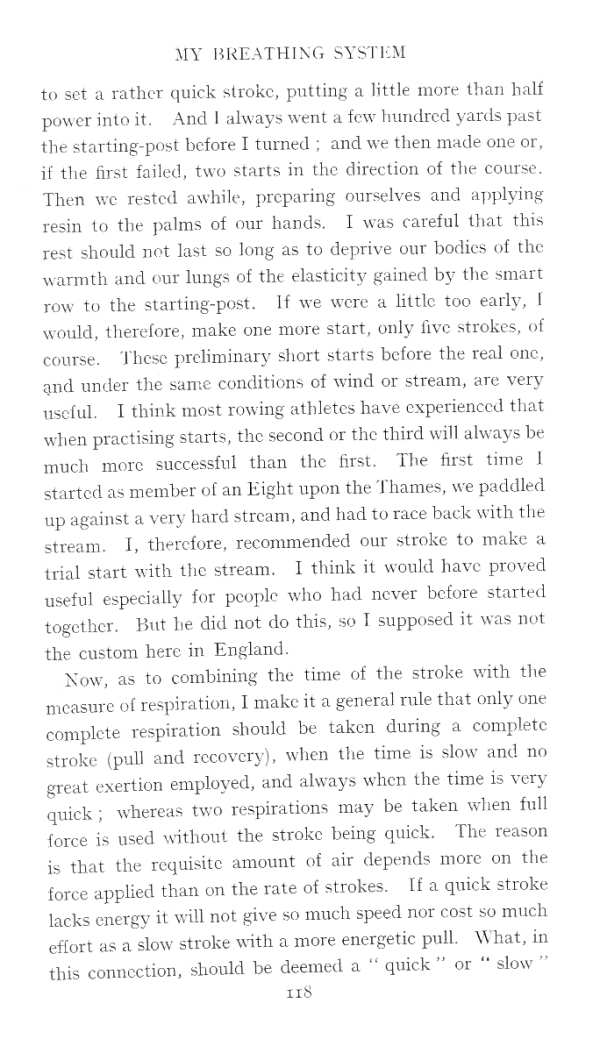22466 mbs 118

MY BKEATHING SYSTEM
to set u rathcr quick strokc, putting a little morę than lmlf power into it. And I always went a few hundrcd yards past tlie starting-post before I tumed : and we tlien madę one or, if the first failed, two starts in the direction of tlie course. Tlien we restcd awhile, prcparing ourselves and applying resin to tlie palrns of our hands. I was caieful tłiat tliis rest should not last so long as to deprive our bodies of the warmth and our lungs of the elasticity gained by tlie smart row to the starting-post. lf we werc a little too early, I would, therefore, make one morę start, only flvc strokes, of course. Tliesc prcliminary short starts before the real one, and under tlie same conditions of wind or stream, are verv useful. I think most rowing athletes have esperieneed tliat włien practising starts, the second or the third will always be much morc successful than the first. The first time I started as member of an liight upon the Thaines, we paddled up against a very liard stream, and had to race back with the stream. I, therefore, recommended our strokc to make a trial start with the stream. I think ii would havc proyed useful especially for pcojilc who had ncver before startetl together. Hut be did not do this, so I supposed it was not the custom herc in England.
Xow, as to combining the time of tlie stroke with the nicasure of respiration, I make it a generał rule that only one complete respiration should be taken during a completc stroke (puli and recovcry), w hen the time is slow and no great exertion employed, and always when the time is vcry ąuick ; whereas two respirations may be taken when fuli force is used with out the strokc being quick. The reason is that the rcquisitc amount of air depends morc on the force applied than on the ratę of strokes. If a ąuick stroke lacks energy it will not give so inucli speed nor cost so much effort as a slow stroke with a morę energetic puli. W hat, in this connection, should be deemed a “ ąuick ” or “ slow "
Wyszukiwarka
Podobne podstrony:
mbs 030 MY BKEATHING SYSTEM peaceful repose they are to look for liuppiness and strcngth during the
mbs 073 MY BREATHING SYSTEM Even if the heart has been weakened by athletics badly per-formed, it is
mbs 068 MY BREATHING SYSTEM I think I was the first author who prescribed exactly, in each single cx
mbs 013 MY BRKATIIING SYSTEM of gymnastics are to be competed for, or demonstrated at the Games, rea
mbs 027 MY BREATHING SYSTEM sucked in. For persons who lind it very difficult to acquire tłiis contr
mbs 035 MY BREATHING SYSTEM How to Expand and Contract the Thorax to its fullest Extent The thoracic
mbs 047 MY BREATHING SYSTEM are so strong that they are able to break a chain, put around the chest,
mbs 062 MY BREATHING SYSTEM inhalation, as a part of " my complete breath,” no attention should
mbs 063 MY BREATHING SYSTEM beginncrs to assist with the hands in the following manner : Takc tbem a
mbs 067 MY BREATHING SYSTEM The Great Mistake of Swedish Drill. As already mentioned, we ought to us
mbs 082 MY BREATHING SYSTEM portant, if everyone, from childhood, were to perform this five minutes’
mbs 090 MY BREATHING SYSTEM EXERCISE No. 3. Fuli breatbing during twisting of trunk to alternate sid
więcej podobnych podstron